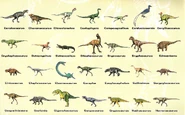
Chirostenotes (/ˌkaɪərɵˈstɛnɵtiːz/ KY-ro-STEN-ə-teez; named from Greek 'narrow-handed') is a genus of oviraptorosaurian dinosaur from the late Cretaceous (about 76.5 million years ago) of Alberta, Canada. The type species is Chirostenotes pergracilis.
History of discovery
Description
Chirostenotes was characterized by long arms ending in slender relatively straight claws, and long powerful legs with slender toes. In life, the animal was about 2 metres (6.6 ft) long. Chirostenotes was probably an omnivore or herbivore, based on evidence from the beaks of related species like Anzu wyliei and Caenagnathus collinsi.
In 2005 Phil Senter and J. Michael Parrish published a study on the hand function of Chirostenotes and found that its elongated second finger with its unusually straight claw may have been an adaptation to crevice probing. They suggested that Chirostenotes may have fed on soft-bodied prey that could be impaled by the second claw, such as grubs, as well as unarmored amphibians, reptiles, and mammals. However, if Chirostenotes possessed the large primary feathers on its second finger that have been found in other oviraptorosaurs such as Caudipteryx, it would not have been able to engage in such behavior.




